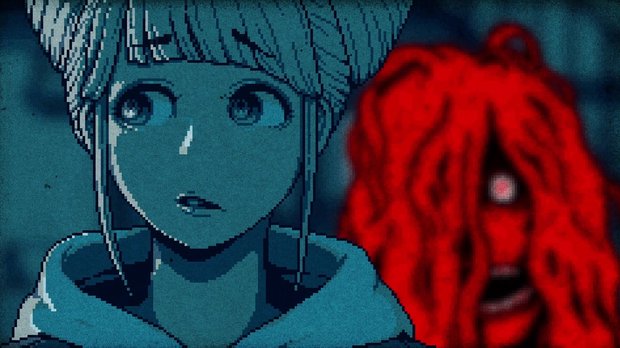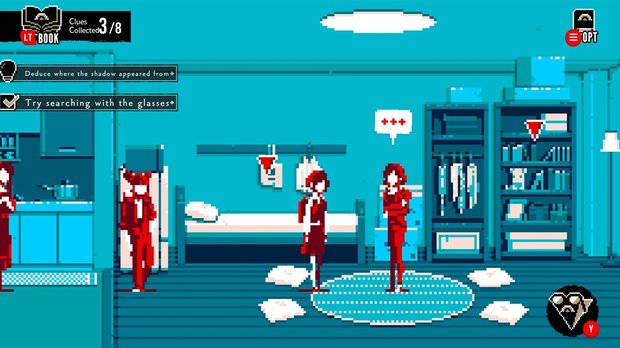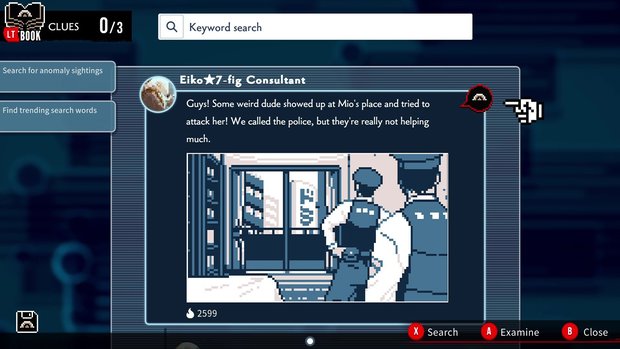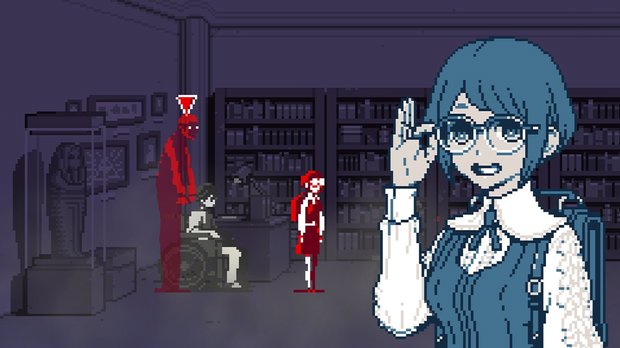Urban Myth Dissolution Center review

- 0 Comments
Any real sense of player freedom quickly dissipates in this otherwise great-looking paranormal Japanese mystery
Urban Myth Dissolution Center is a Japanese pixel art game with an unusual premise. Rather than investigating mysteries exclusively in the natural world, we’re looking into the things that make urban myths spread, and getting to the bottom of what’s really going on, even if their roots are in another, supernatural world entirely. With the game set in Japan, you might be expecting to unravel some weird and wacky tall tales from Japanese legend, but sadly most of the chapter cases, bar one, feel quite run-of-the-mill. The end result is a game that is fantastically presented, with a bold art style and an intriguing premise, but once unpacked it’s let down by some repetitive content, slow pacing and limited player agency.
You play as the rather naive Azami Fukurai, who turns up at the titular organisation, a place that looks into anomalies beyond the usual scope of the police force, seeking a cure for her own visions of spirits. However, through some blatant trickery from the agency’s boss, Ayumu Meguriya (who arranges for Azami to break a cursed relic so she is made to work for the center to repay her debt), Azami suddenly finds herself part of the investigation team instead, alongside her driver Jasmine.
There are six cases in all to investigate, each one separate from the last in terms of story, though there is an overarching plot involving our heroine that reveals itself across the chapters too. In each case, you’ll need to essentially identify what the urban myth is by speaking to witnesses and exploring the scene, then move to the “dissolution” phase where you make some deductions to determine what’s actually happening. For example, in the first case a troubled woman keeps seeing a weird figure appearing in her room. Is this actually an entity from the “Man Under the Bed” urban legend, where a crazed figure crawls out from beneath people’s beds, or is there a simpler explanation?

To aid her in her investigations, Azami has been given some snazzy glasses by the Director to help focus her “clairvoyance” skill, which is how she’s been seeing spirits in the first place. This means that as well as speaking to people in the present, she can also pop on her glasses and see memories from the past, indicated by ghost-like presences in bright red, which she can observe further for more clues. This is a nice extra mechanic that fits in well with the occult-like theme.
Before you even arrive at the scene of a case, you’ll be asked to take a look at social media to see what related rumours are flying around and what people are talking about. You’ll scroll through a page of people’s comments and pictures about the case, gathering information about who is involved and what the problem is. Those nifty glasses also have a use here, as certain words jump out on the screen, and when analysed with Azami’s sharp specs can be added to a list of search terms that you can use to scour the internet for further clues. This is a nice idea to break up the full investigation scenes, but as with those parts, it also feels quite slow-paced. You’re often scrolling through many comments until you find a search term, and sometimes there are several pages to look through.

Once at a scene in the field, the proper investigation can take place. This involves taking a closer look at points of interest in the environment, as well as a lot of going back and forth speaking to witnesses with various dialogue options. (You’ll usually need to go through every one to find all the clues required to make the scene automatically move onto the next part of the story.) There are two deduction-like scenes the game presents to make you use your old grey matter a (slight) bit more. The first appears when you meet a new character. Once you’ve quizzed them, you will be questioned on a certain aspect of what they just said, so that Azami can add more about the character in her journal, which holds details about each case. This is done using very simple multiple choice options, and as you’ve literally just spoken to the person, it is pretty hard to get wrong (and if you do, you’re just told to take another look until you get it right).
The second deduction mechanic is when Azami needs to make a hypothesis about the case. There’s a range of phrases to fit into two or three empty slots in a sentence such as “When _____ did _____ then _____.” This is no complex Golden Idol-like puzzle; whilst I did sometimes find it hard to figure out exactly what the sentence was trying to get at, the choices are limited, and if I failed to get it right I simply had to go back again and swap out the phrases marked as incorrect to try again. It’s great that there is an extra element of detective work added to make this feel different from a pure visual novel, but when the mechanic can just be brute forced it doesn’t give you much sense of truly working things out.
This feeling permeates the whole of the investigation phase. You never have any choice in how to ask a question or what you want to know, you’re just running through the motions, ticking off every action in a scene until you can move onto the next one. Often your options with a specific object will be things such as “observe” and then “look more” without really explaining how this differs and why you’re doing it. Each chapter tends to involve seven or eight scenes of speaking to everyone / observing everything in them, so it can be quite slow going to get through it all. It’s clear that the team have tried to spice up the visual novel element with added detective gameplay, but when the mechanics feel so watered down and there’s no choice involved, it’s harder to care that they’re there.
The stories themselves do have interesting twists and turns, despite not featuring the most outlandish urban myths. The third chapter, where you go undercover inside an infamous ghost tour where people keep disappearing, is a standout, because along with speaking to the participants, you’re also solving riddles and quizzes from the ghost tour leader and trying to keep everyone’s suspicions of why you’re there at bay. They’re never very frightening, though, and I was expecting the cases to feature scarier legends or characters. Whilst they certainly aren’t vanilla, there isn’t quite the sickening detail that you might expect of a game delving into a culture that features such a huge breadth of dark and fascinating stories.

The one benefit of having chapters progress relatively slowly is that there’s plenty of room for dramatic build-up and rug pulls. Case in point is the ending, which finally explains more about Azami’s backstory. I’m not sure how I feel about the game’s final twist, which does lean a bit heavily on overused plot tropes, but one thing’s for certain – it definitely livens up the climax and provides a really unexpected revelation to end on.
In general the writing can feel a little basic, although this could be partly down to the translation. Azami is your extremely trusting and apologetic anime heroine, whilst Jasmine, your driver sidekick, is feisty and spirited. Meanwhile, the UMDC Director is consistently enigmatic. That’s pretty much all we get out of these characters in their dialogue (at least until the final plot twist). It would have been nice to have seen Azami grow in confidence or feel less submissive as she completed more cases, but there doesn’t seem to be much thought put into making her anything but your standard anime girl.
Speaking of anime, the game looks fantastic, especially in the animated cutscenes that introduce and finish chapters. Featuring a distinctively limited colour palette, the pixel art style switches between traditional third-person viewpoints when investigating a location to a more detailed visual novel style when talking to characters up close. The bold red accents and bright blues of the investigation scenes are simple but effective, while the grander anime style of the “dissolution” scenes, with the Director’s bright yellow eye of knowledge peering down at the evidence we’ve collected, offer more creative flourishes not found elsewhere.
The soundtrack doesn’t quite live up to the visual heights. There’s no voice acting and sound effects are used sparingly, but there are a few synthesised tracks that change according to the current mood and phase of the game (investigation phase, hypothesis phase, etc.). These get repeated in each case, so they start to feel a bit same-y by the sixth time round. That said, I did enjoy the track that featured (what I assumed to be) Japanese rapping, if only because it’s something I haven’t heard very often before!
Final Verdict
If you can shake off the game’s reliance on slow pace and repetition, there’s still a decent amount to enjoy about exploring Urban Myth Dissolution Center’s unusual plot points. It takes too long to reach its surprising payoff (about fifteen hours for me) but each chapter has a fair few mini surprises to keep them interesting. Whether it’ll be enough to hold your interest probably depends on if you’re hoping for something more than just a standard visual novel. This game may look as if it puts you in charge of your own investigations, but any freedom is largely illusory. There are some reasonably interesting stories to uncover here, but if you want to really play detective, you may be better off trying other games with meatier mechanics and leaving this particular urban legend to the rumour mill.
Hot take
Urban Myth Dissolution Center’s bold art and an even bolder concept isn’t quite enough to spice up this slow-burning mystery visual novel with limited detective elements.
Pros
- Stylish pixel art
- Delving into Japanese myths adds a unique spin to the investigation genre
- Plenty of plot twists and surprises keep coming until the very end
Cons
- Cases are slow-paced and get repetitive
- Deduction mechanics are pretty simplistic and can be brute forced
- Characters, especially the heroine, are standard cliched anime tropes
Laura played Urban Myth Dissolution Center on PC using a review code provided by the game's publisher.











0 Comments
Want to join the discussion? Leave a comment as guest, sign in or register.
Leave a comment